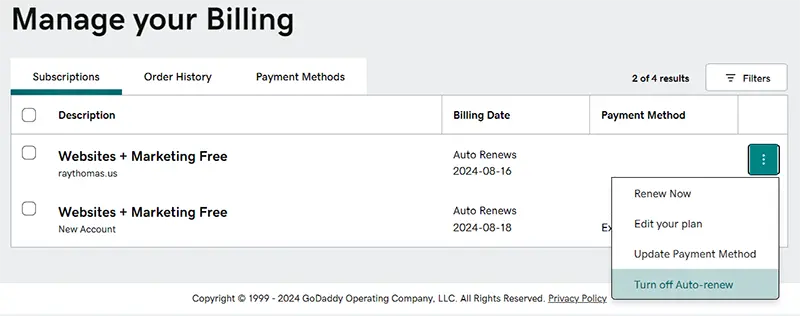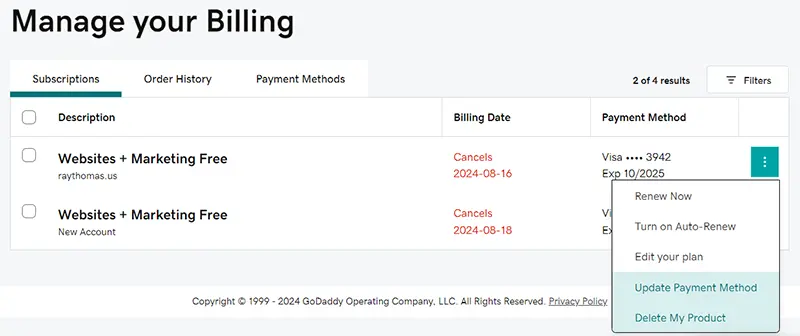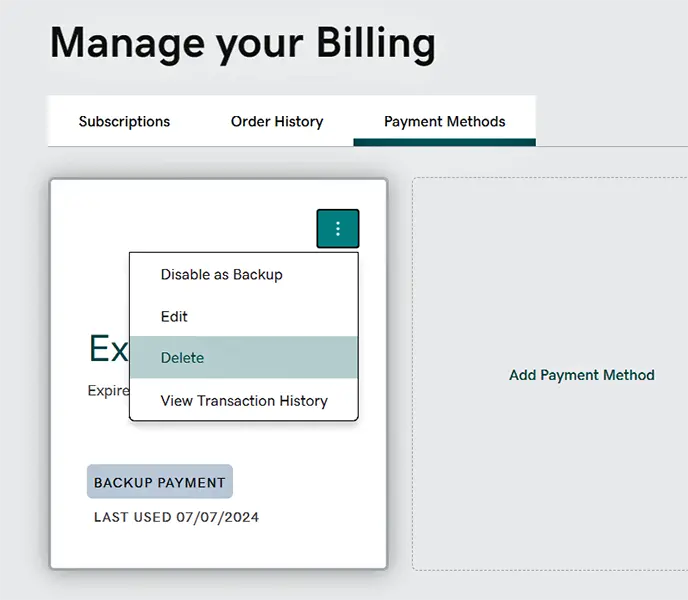Introduction
In June 2024, I was trying to get the old Perl webring system Ringlink to work. One problem I had was getting the program to send emails from the program. What I realized was that I needed a domain level email system. I had been using Godaddy as a domain name registrar since 1999, and DNSExit for dynamic DNS since 2011, so looked at what those services offered.
Godaddy looked very promising at just $1.99 per month, $23.88 per year, but looking at the small print, that's just for the first year. After that it is $95.88 annually. DNSExit offers several tiers of service and even a free one which is all I needed.
While looking at both sites I saw that I was paying Godaddy around $21 to $23 a year for each domain name I had registered with them, but could do the same at DNSExit for less than $13 each. There are not many registrars cheaper than that so on July 17, 2024, I decided to consolidate the services I use at DNSExit and started the domain name registrar transfer process from Godaddy to DNSExit.
Godaddy does not have a listing of domain name renewal prices. It only shows the renewal prices after you have registered a domain which should be a warning sign of how expensive it can be, but DNSExit does.
This page was written to show how I did this.
Cost
Under the Internet Corporation for Assigned Names and Numbers (ICANN) rules, both the current registrar and new one are allowed to charge a fee for the transfer of domain names from one to the other. From what I have read, it is normal for only the receiving or winning registrar to charge.
When I did it, Godaddy, as the "losing" registrar did not charge a fee, while DNSExit charged the same price, a little under $13 each, as renewing a domain name but registered the domain name for another year.
At Godaddy
Auto-renewal
After reading the instructions on both Godaddy and DNSExit, I signed into my GoDaddy account went to the Domains in the "Renewals & Billing" section and turned off anything to do with auto-renewal. I did this so that any domain close to being renewed would not be changed while the transfer process which takes up to 14 days, was in progress.
Locks
From the domain management page, I turned of the domain locks. In order to trasnfer domains the locks must be off.
Privacy
Domain privacy has to be turned off for the transfer to proceeed. This is because with it turned on the contact information is given as [domain-name]@domainsbyproxy.com, but the real domain registrant's contact information is needed. There are some domains, such as the US ones I have, that do not use privacy settings.
Start the Transfer
For each domain to be transferred, I went to the domain's management panel and clicked on "Transfer to Another Registrar." For each domain Godaddy produced a 16-digit authorization code. These need to be made a note of, but they are also emailed to you.
The .CO.UK domains are a little different as are not given transfer authourization codes. Instead, the new registrar's Internet Provider Security (IPS) tag is used. The IPS tag system is a standard required by Nominet, the .uk domain name registry service, and is used to identify the hosting company associated with a specific .uk domain name. I contacted DNSExit's support to get their IPS tag.
Special Case Domains
.US domain names do not have the normal hidden domain privacy settings.
.CO.UK domains are not given transfer codes. Instead, the new registrar's Internet Provider Security (IPS) tag is used. The IPS tag system is a standard required by Nominet, the .uk domain name registry service, and is used to identify the hosting company associated with a specific .uk domain name. I contacted DNSExit's support to get their IPS tag.
At DNSExit
At DNSExit, I logged into their system and went to their Domain Transfer page. I entered the domain name to be transferred along with the 16-digit authourization code produced for each domain by Godaddy,.DNSExit will send an email that the transfer hss been initiated.
I was not sure what would happen about the .CO.UK domains and emailed DNSExit's support to tell them that I wanted those domains transferred as well.
After a couple of days, Godaddy emailed me saying that the domain had been removed from my account with them. DNSExit then sent emails saying the domains had been successfully transferred to them.
I logged into both services and confirmed that all the domains had been transferred and were where they should be.
Differences: Godaddy vs DNSExit
Speed
DNSExit's control interface is definitely slower and less polished than Godaddy's.
Privacy
Private domain registration records are provided by Goddy for free. At DNSExit the service costs $1.99 per domain per year.
SSL
SSL certificates are free at DNSExit who use Let's Encrypt as the provider. The certificates are valid for 90 days. Godaddy charges $69.99 per domain per year, payable for 3 years. That means an initial payment of $209.97. As with many Godaddy services the price increases after the first use and to renew the certificates costs $299.97.
At the moment I use Certbot to renew my own certificates at Let's Encrypt for the domains. Now I am at DNSExit, I will probably let them manage the certificates.
Tidying Up
Transferring the domains from Godaddy to DNSExit was started on July 17, 2024. It was completed on July 26, 2024 but here was still a little work to do...
Private Registration
Private registration at Godaddy was free, and the email address used was [domain-name]@domainsbyproxy.com. I wanted private registration at DNSExit and that cost $1.99 per domain name per year. The email address used by DNSExit is [domain-name]@private.netdorm.com
Checking Site Availability
I self-serve three websites, the domain names either point directly to those or at the moment unused and I keep them for future projects. To ensure the domains are pointing to the correct websites outside of my own network, I used GeoPeeker, and LocaBrowser to check the sites.
Closing Godaddy
As I thought I has no other products from GoDaddy, I also clicked on the dropdown in the top right by my account name and went into the "Renewals & Billing" section of my account, then clicked on the "Payment Methods" tab and tried to remove my credit card information. This was not as easy as it could be because it wants a replacement payment method and will not delete the original. What is going on?
Sometime in the past when I registered a doman name Godaddy set up a free Websites + Marketing plan for it. You can see these by going to the My Products page.

Godaddy 'My Products' page showing Websites + Marketing
I went back to the "Renewals & Billing" page and this time clicked on the "Subscription" tab. The two Websites + Marketing plans can be seen there as well. Although they are free, they are set to auto-renew. For each of them, I turned off the auto-renew feature.

Turning off Godaddy's Websites + Marketing auto-renew
With auto-renew turned off, a couple of new choices appear in the control dropdown appear. Among them is the option to delete the product.

Deleting Godaddy's Websites + Marketing product
But, you're still not finished. Godaddy will send an email asking if you really, really want to delete the products. Once the email is answered and another confirmation on the website clicked on, you can click on the "Payment Methods" tab and the credit card information can finally be removed from Godaddy.

Deleting credit card information from Godaddy
None of this takes long to do, but it is not obvious. You just have to remember to turn off auto-renew on all the services, even the ones they set up for you, before you can delete the credit card information. It is understandable that Godaddy should do this, they don't want to lose revenue and they certainly do not want their customers deleting services by accident.
Removing the services and credit card information does not delete the account. If needed you can always sign back into it.
Trivia
The Internet Corporation for Assigned Names and Numbers (ICANN) is charged with ensuring the internet's stable and secure operation. As part of that they have the Internet Assigned Numbers Authority (IANA) which among other things such as overseeing the global IP address allocation Domain Name System (DNS).
In July 2024, IANA lists 1,591 top-level domains. Some are reserved to everyone and some are reserved to certain entitites such as .edu domains but most are freely available to everyone who cares to register them.
Of the ones listed by IANA, DNSExit offers 902 of them. The annual cost of them ranges from $5.00 for .name.ng to $4,657.96 for .na domains. If you were to register for all the ones offered it would cost $88,505.91 a year. Even then, if you want all of them, there's still over a third of all possible domains to go.
Sources and Resources
Certbot
DNSExit
DnsExit FAQ: Transfer Domains (DNSExit)
Domain Transfer (DNSExit)
Domains - UK domain names (Nominet)
FAQs for Registrants: Transferring Your Domain Name (ICANN)
Free Let's Encrypt SSL Certificates (DNSExit)
Goddady
How to transfer a domain from GoDaddy (Namecheap)
Let's Encrypt
Root Zone Database (IANA)
SSL CErtificates (Godaddy)
Transfer my domain away from GoDaddy (Godaddy)
Unlock or lock my domain (Godaddy)
What is Domain Privacy? (Godaddy)
What is an IPS tag? (Namecheap)
What is Private Registration (DNSExit)
What is the IPS TAG? (Hostgator)